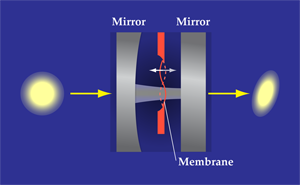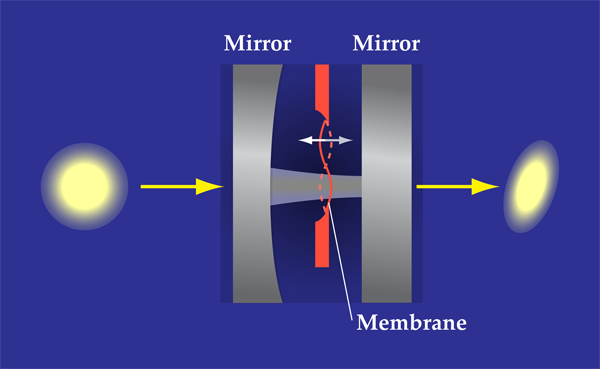Vibrating Membrane Puts a Squeeze on Light
The interaction between laser light and a mechanical oscillator, such as a movable mirror, can be used to control light’s quantum properties for a number of applications. One coveted function of this optomechanical interaction is the generation of squeezed states of light. These are quantum states of light that are engineered to be less noisy than light limited by shot noise, which is the result of fluctuations that come from the discrete particle nature of photons. In Physical Review X, Tom Purdy and colleagues at the University of Colorado, Boulder, demonstrate that light can be squeezed by having it interact with a small, vibrating ceramic membrane [1]. Their result represents the greatest suppression of noise in a light beam using an optomechanical setup, and it could lead to more sensitive optical interferometry for applications in biology and the detection of gravitational waves.
Heisenberg’s uncertainty principle says it is impossible to measure two complementary observables, such as the position and momentum of a particle, with arbitrary precision. In the case of light, the uncertainty principle prohibits a perfectly precise measurement of both the amplitude and phase of a light beam, requiring that the product of the two uncertainties be greater than ħ/2 (in properly normalized units.)
There are different ways to work within the limits of the uncertainty principle to perform low-noise experiments with light. One strategy is a shot-noise-limited measurement, in which a laser light beam is prepared in a coherent state, with equal uncertainties in the amplitude and phase of the light. In contrast, a squeezed state is a specially engineered quantum state where the uncertainty in one quantity (say, the phase) is reduced below the shot-noise limit. This reduction must come at the cost of greater uncertainty in the other quantity by an amount that ensures the product of the uncertainties doesn’t violate the uncertainty principle. Squeezed states of light can be particularly useful in measurements where the phase of light needs to be measured more precisely than the amplitude, or vice versa.
To prepare a squeezed state, the noise in both the amplitude and phase of a light beam has to be simultaneously manipulated. This is usually accomplished by having the light pass through a medium in which its amplitude exerts a feedback on its phase. Researchers first accomplished this experimentally in 1985 [2] with nonlinear optical media, in which the index of refraction varies with the light’s intensity. It took more than two decades of further work before these states were ready for a practical application. Namely, improving the shot-noise-limited sensitivity of kilometer-scale laser interferometers, which are the basis of gravitational wave detectors [3,4].
An alternative to nonlinear optical media that may prove to be more flexible and cost effective is to perform what is called ponderomotive squeezing [5]. First proposed over four decades ago, the idea is to couple light’s amplitude to its phase by using radiation pressure to push on a mechanical object that, in turn, feeds back on the light’s phase. Figure 1 illustrates a simple way to think about this. Radiation pressure exerts a force on a mechanical oscillator inside of a cavity, causing it to move. The motion causes a shift in the phase of the light field, thus coupling the amplitude (intensity) and phase of the intracavity light field.
It is only in the past two years that this technique has been realized experimentally, in three rather distinct experimental settings: an ensemble of ultracold atoms in an optical cavity [6], a micromechanical resonator coupled to a nanophotonic cavity [7], and now, in the University of Colorado group’s new work, by placing a vibrating membrane in the middle of an optical cavity [1]. In all three cases, the mechanical oscillators have a high quality factor, meaning they oscillate at a sharp resonant frequency with a low energy loss. The oscillators also have to be cooled to cryogenic temperatures so that any thermally induced motion is small compared to the radiation-pressure induced motion. The optical cavity is important because it boosts the strength of the optomechanical coupling between the intense laser beam and the oscillator.
In their setup, Purdy et al. placed a low-mass partially reflective membrane made of silicon nitride in the middle of an optical cavity and cooled the membrane to about 1 millikelvin. The incoming light beam was in a coherent state, with an equal amount of noise in the phase and amplitude. This beam exerted a pressure on the membrane, exciting the so-called drumhead vibration mode—an oscillation similar to that generated by a person jumping in the middle of a trampoline—which oscillates at a resonant frequency of 1.5 megahertz. The strong optomechanical coupling in their setup allowed them to squeeze light by 32% ( 1.7 decibels) below the shot-noise limit. Depending on the phase of the squeezed light relative to a reference light field, the researchers could maximize the squeezing in either the amplitude or the phase.
The level of squeezing Purdy et al. have achieved doesn’t yet match that generated by nonlinear optical media, which, as of several years ago, exceeded 10 decibels [8]. But Purdy et al. have made a significant step forward by demonstrating the highest level of squeezing in an optomechanical system. The recent achievements are sufficient to start thinking about using squeezed states in precision optical measurements. Possibilities include laser-interferometer-based gravitational wave detectors or quantum information systems. There is one main caveat, though: For optomechanically squeezed light to be used to improve the shot-noise-limited performance of laser interferometers, such as the one at the Laser Interferometer Gravitational-Wave Observatory (LIGO), the squeezing would have to occur in a frequency range of 10 hertz to 10 kilohertz (the gravitational wave signal band), while Purdy et al.’s experiment was performed at a much higher frequency of 1.5 megahertz. But this is a technical issue, rather than a fundamental one, and ultimately solvable—say by using a different membrane, or squeezing the light at frequencies away from the oscillator’s resonant frequency. The recent advance in optomechanical squeezing is no doubt a significant step forward in establishing a new method for generating squeezed states of light, and it is a result to be celebrated.
References
- T. P. Purdy, P-L. Yu, R. W. Peterson, N. S. Kampel, and C. A. Regal, “Strong Optomechanical Squeezing of Light,” Phys. Rev. X 3, 031012 (2013)
- R. E. Slusher, L. W. Hollberg, B. Yurke, J. C. Mertz, and J. F. Valley, “Observation of Squeezed States Generated by Four-Wave Mixing in an Optical Cavity,” Phys. Rev. Lett. 55, 2409 (1985)
- The LIGO Scientific Collaboration, “A Gravitational Wave Observatory Operating Beyond the Quantum Shot-Noise Limit,” Nature Phys. 7, 962 (2011)
- The LIGO Scientific Collaboration, “Enhanced Sensitivity of the LIGO Gravitational Wave Detector by Using Squeezed States of Light,” Nature Photon. 7, 613 (2013)
- V. B. Braginsky and A. B. Manukin, “Ponderomotive Effects of Electromagnetic Radiation,” Sov. Phys. JETP 25, 653 (1967)
- D. W. C. Brooks, T. Botter, S. Schreppler, T. P. Purdy, N. Brahms, and D. M. Stamper-Kurn, “Non-Classical Light Generated by Quantum-Noise-Driven Cavity Optomechanics,” Nature 488, 476 (2012)
- A. H. Safavi-Naeini, S. Groeblacher, J. T. Hill, J. Chan, M. Aspelmeyer, and O. Painter, “Squeezing Of Light Via Reflection from a Silicon Micromechanical Resonator,” arXiv:1302.6179 (2013)
- H. Vahlbruch, M. Mehmet, S. Chelkowski, B. Hage, A. Franzen, N. Lastzka, S. Goßler, K. Danzmann, and R. Schnabel, “Observation of Squeezed Light with 10-dB Quantum-Noise Reduction,” Phys. Rev. Lett. 100, 033602 (2008)





